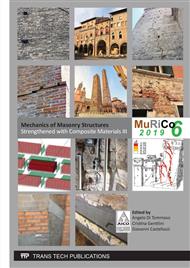[1]
Ciancio D, Jaquin P, Walker P. Advances on the assessment of soil suitability for rammed earth. Constr Build Mater 2013;42:40–7.
DOI: 10.1016/j.conbuildmat.2012.12.049
Google Scholar
[2]
Hall M, Djerbib Y. Rammed earth sample production: Context, recommendations and consistency. Constr Build Mater 2004;18:281–6.
DOI: 10.1016/j.conbuildmat.2003.11.001
Google Scholar
[3]
Jayasinghe C, Kamaladasa N. Compressive strength characteristics of cement stabilized rammed earth walls. Constr Build Mater 2007;21:1971–6.
DOI: 10.1016/j.conbuildmat.2006.05.049
Google Scholar
[4]
Miccoli L, Müller U, Fontana P. Mechanical behaviour of earthen materials: A comparison between earth block masonry, rammed earth and cob. Constr Build Mater 2014;61:327–39.
DOI: 10.1016/j.conbuildmat.2014.03.009
Google Scholar
[5]
Loccarini F. Behaviour of rammed earth structures: sustainable materials and strengthening techniques. Doctorate Thesis. University of Florence; University of Braunschweig - Institute of Tecnology, (2017).
Google Scholar
[6]
Miccoli L, Oliveira D V., Silva R a., Müller U, Schueremans L. Static behaviour of rammed earth: experimental testing and finite element modelling. Mater Struct 2014:3443–56.
DOI: 10.1617/s11527-014-0411-7
Google Scholar
[7]
Bui QB, Morel JC, Venkatarama Reddy B V., Ghayad W. Durability of rammed earth walls exposed for 20 years to natural weathering. Build Environ 2009;44:912–9.
DOI: 10.1016/j.buildenv.2008.07.001
Google Scholar
[8]
Bui Q-B, Hans S, Morel J-C, Do A-P. First exploratory study on dynamic characteristics of rammed earth buildings. Eng Struct 2011;33:3690–5.
DOI: 10.1016/j.engstruct.2011.08.004
Google Scholar
[9]
Jaquin P. A. Analysis of historic rammed earth construction. 2008. Durham theses, Durham University. Available at Durham E-Theses Online: http://etheses.dur.ac.uk/2169/.
Google Scholar
[10]
Nabouch R El, Bui Q, Perrotin P, Plé O, Plassiard JP. Modélisation numérique de structures en pisé : analyses et recommandations Rencontres Universitaires de G´enie Civil, May 2015, Bayonne, France.
Google Scholar
[11]
Fagone M, Loccarini F, Ranocchiai G. Strength evaluation of jute fabric for the reinforcement of rammed earth structures. Compos Part B Eng 2017;113:1–13.
DOI: 10.1016/j.compositesb.2016.12.054
Google Scholar
[12]
Loccarini F, Fagone M, Ranocchiai G, García Manrique JA, Ruiz Checa JR. Bonding capacity of jute fabric reinforcements of earthen structural elements. An experimental analysis. Brick Block Mason. Trends, Innov. Challenges - Proc. 16th Int. Brick Block Mason. Conf. IBMAC 2016, 2016, p.843–8.
DOI: 10.1201/b21889-105
Google Scholar
[13]
Briccoli Bati S, Fagone M, Loccarini F, Ranocchiai G. Jute fabric to improve the mechanical properties of rammed earth constructions. Versus2014 - Earthen Archit., 2015, p.55–60.
DOI: 10.1201/b17392-14
Google Scholar
[14]
Briccoli Bati S, Fagone M, Loccarini F, Ranocchiai G. Analysis of rammed earth arches strengthened with natural fibers. Civil-Comp Proc 2013;102.
DOI: 10.4203/ccp.102.78
Google Scholar
[15]
Briccoli Bati S, Fagone M, Rotunno T. Lower Bound Limit Analysis of Masonry Arches with CFRP Reinforcements: A Numerical Method. J Compos Constr 2013;17:543–53.
DOI: 10.1061/(asce)cc.1943-5614.0000350
Google Scholar
[16]
Fagone M, Kloft H, Loccarini F, Ranocchiai G. Jute fabric as a reinforcement for rammed earth structures. Compos Part B 2019:107064.
DOI: 10.1016/j.compositesb.2019.107064
Google Scholar
[17]
Rotunno T, Fagone M, Bertolesi E, Grande E, Milani G. Single lap shear tests of masonry curved pillars externally strengthened by CFRP strips. Compos Struct 2018;200:434–48.
DOI: 10.1016/j.compstruct.2018.05.097
Google Scholar
[18]
Corbin A, Augarde C. Fracture Energy of Stabilised Rammed Earth. Procedia Mater Sci 2014;3:1675–80.
DOI: 10.1016/j.mspro.2014.06.270
Google Scholar
[19]
ADINA, Theory and Modeling Guide, Vol I: ADINA solids &Structures, August 2015, ADINA R & D, Inc., 71 Elton Avenue, Watertown, MA 02472 USA.
Google Scholar
[20]
ABAQUS 2018. Theory and user's manuals 2018. Pawtucket (RI, USA): Hibbit, Karlsson and Sorensen.
Google Scholar
[21]
ANSYS. ANSYS Mechanical APDL Theory Reference. Release 19. ANSYS Inc Southpointe 2600 ANSYS Drive Canonsburg, PA.
DOI: 10.1016/b978-0-12-811768-2.00022-5
Google Scholar


